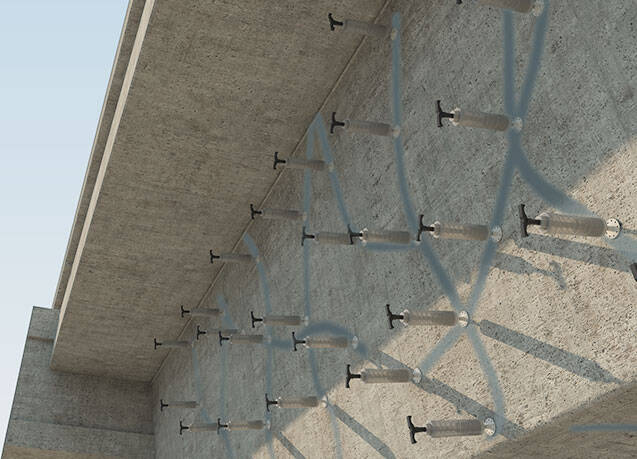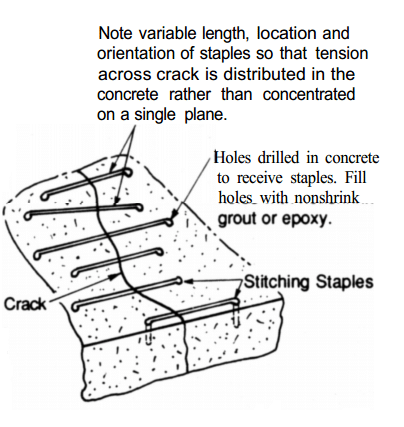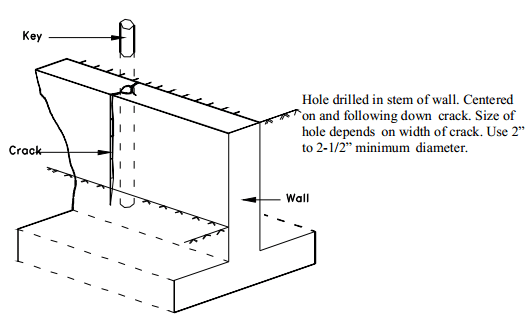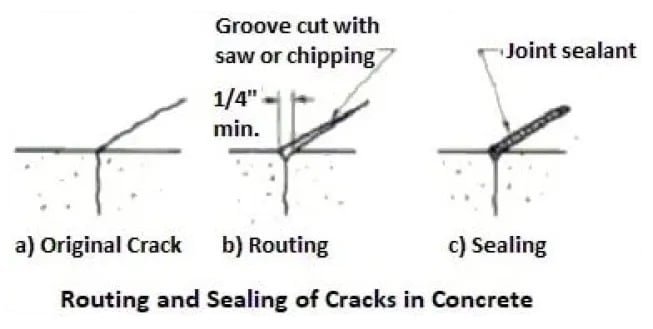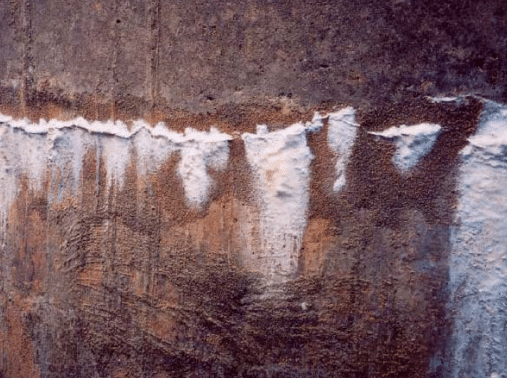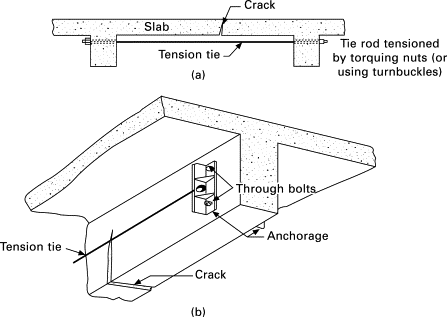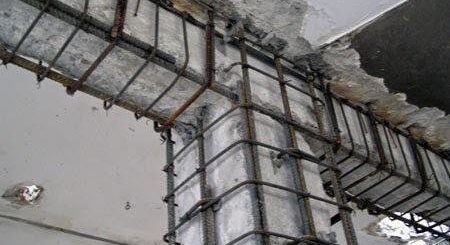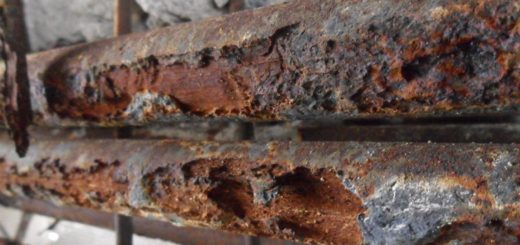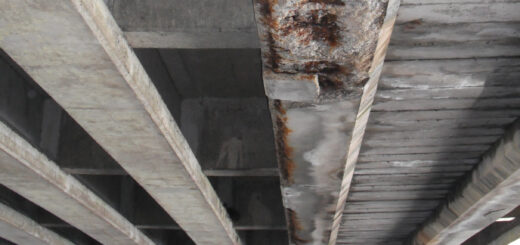Concrete Crack Repair – Methods & Procedures
Cracking of concrete and concrete crack repair is very common in the construction of concrete structures. Cracking concrete is inevitable. However, the depth and width of the crack matter.
- Having a crack width less than 0.1mm is not considered an issue in the water retaining structures where the esthetic appearance is a concern.
- Generally, the limiting value of the crack width for water retaining structures are 0.2mm
- For normal structures, crack width is limited to 0.3mm. However, this value may be required to adjust depending on the exposure class.
Another concern of the concrete cracks is the depth of the crack. The formation of cracks up to the reinforcements is the main issue with respect to the durability of the structure. Corrosion of reinforcements and rapid deterioration of the structure could experience with this.
Why Concrete Crack?
The formation of cracks in the could be due to many reasons. Some of the major reasons are as follow.
- Shrinkage Cracks
- Thermal cracks – due to the heat of hydration
- Thermal cracks – due to the change in temperature of the structures
- Structural cracks
- Cracking due to chemical reactions
Concrete Crack Repair Methods
Depending on the treatment made to the crack and the nature of the repair is used to categorize the different methods of concrete crack repair.
- Epoxy Grout Injection
- Polyurethane Injection
- Stitching
- Patching
- Gravity Filling Methods
- Drilling and Plugging Method
- Flexible Sealing – Grooving and Sealing
- Autogenous Healing
- Movement Joints, Expansion Joints and Contraction Joints
In addition to the above, there are other methods to treat cracked concrete. They are not directly related to the sealing of the cracks, but they can also be considered as a secondary method for the issues. Further, some of these methods may require one of the above methods to seal the cracks. Sealing the crack by flexible sealant could be done to avoid the deterioration of concrete and corrosion of reinforcement.
Secondary methods – Indirect Methods – when a crack affect the structural capacity
- Adding Additional Reinforcements
- Prestressing
- FRFP
- Steel beam support
- Increasing section
- Provide additional supports
Let’s discuss each type of crack sealing method in detail.
Epoxy Grout Injection
Let’s what is epoxy grout. It is a type of grout having the following features.
- Very low viscosity
- Nonshrink
- Grater bond to the steel than the cement
- High bond to the concrete, high tensile capacity than normal concrete
- Develop high compressive strength than the concrete
- High shear bond strength
- High chemical resistance
Epoxy grout is flowable and can be penetrated into very small cracks. Further, it will be applied with pressure allowing it to fill the whole crack. It is more suitable type of structural crack repairs.
The following procedure can be followed when the concrete crack repair is done with epoxy construction grout.
- The crack could be penetrated up to a certain depth or it could be penetrated across the section.
- Firstly clean the area where the concrete crack repair needs to be done. Laitance, dust, paint, skim coat, etc. shall be removed. This shall be done for a width of about 50mm.
- Generally, the crack repair with epoxy grout will be done by injecting with some pressure.
- Attach the injection nipples. They could be placed at a maximum spacing of about 300mm. The spacing could be selected based on the length of the crack.
- Seal the crack from the surface by using suitable epoxy grout or adhesive material. When the crack has penetrated across the section, nipples could be placed on both sides. For example, in a slab, nipples could be placed on both sides to make sure the whole crack is filled with grout.
- A width of about 50mm could be sealed and the thickness of the sealant applied on the surface could be at least 2mm. It shall be allowed to cure as specified in the product specification.
- Injection of the epoxy grout shall be started from one end when horizontal cracks are sealed. Injection/filling shall be done until it appears that the grout coming out from the next nipple. Then repeat the process.
- Injection of the epoxy grout shall be started from the lower end when a vertical crack is sealed.
- The grout injection pressure could be maintained in the range of 0.1 -0.5 MPa. However, this could be decided in consultation with the engineer and as per the product specification.
Polyurethane Injection
Polyurethane injection is not a common type of concrete crack repair method when compared to the other types. However, it is a more effective and efficient type in the presence of water.
Further, there are advantages and disadvantages of polyurethane injection when compared to epoxy grout injection.
- When there is a concern about material leaking, the polyurethane injection is suitable
- It is not used to repair the structural cracks
- The polyurethane expands about 2-40 times from its original volume. It is suitable for filling the voids in the concrete.
- These elastomeric -fast setting forms are suitable for crack sealing in water retaining structures.
- Polyurethan is very useful as it starts hardening within a few minutes. It reduces the movement of the material from the crack.
- The elastomeric nature of the sealant allows the slight structural movements at the crack.
- High injection pressure may be required to form to inject into fine cracks.
Stitching
Stitching concrete crack repair is not as effective as the epoxy grout filling. It is a method that ties the two-part of concrete separated by the crack.
- A steel bar is inserted into the concrete from either side not to allow the crack the widen.
- It holds the two-segment of concrete together.
- It may be suitable as a structural crack repair, However, in my opinion, it is advisable to select a method like epoxy grout injection when structure crack repair is required.
- This method could be more suitable for no structural members such as brick walls.
- The holes drilled to insert the steel wire/rod could be filled with epoxy grout.
Patching
Patching is one of the simplest and easiest methods of concrete crack repair methods. It does not require complicated tools or high skilled person to do that. However, there should be technical personnel who is capable of following the product specification.
- It is the method of applying the crack sealant on the surface of the crack. When the eustatic appearance is a concern, the sealant will be applied after cutting a groove in the concrete.
- A “V” shape grove will be cut along the crack and it will be filled with the sealant.
- Nonshirnk construction grout is mostly used as the sealant. Its volume does not reduce when it hardens, gains strength very rapidly, the strength of the construction grout is about 50-60N/mm2.
- Nonshrink construction grout can be applied as a past in the cracked area. It even can be applied to slab soffits and vertical surfaces.
Gravity Filling Methods
This method of filling the crack has some similarities to the epoxy grout injection. However, they are not the same. Further, different materials are being used in this method.
- The concrete crack width of about 0.03 mm can even be sealed with this method. It is required to use very low viscosity epoxy grout to do that.
- Normal grout can not penetrate in the smaller width. They may seal the crack partially affecting the structural performance of the structure.
- Since there is no pressure, attention shall be made to the efficiency of the system when a structural crack or crack in a water-retaining structure is sealed.
- When there is uncertainty, it is always advisable to another method such as epoxy grout injection.
- As we know, filling very small crack widths lower than 0.1mm would not be that easy under gravity pressure.
Drilling and Plugging Method
This method of concrete crack repair can not be done always as the pattern of crack is not developing the way we which it will be irregular.
- This method is suitable for cracks formed in nearly a straight line
- Suitable for vertical cracks.
- A hole or several holes can be drilled across the crack.
- Then it can be filled with suitable non-shrink construction grout or epoxy grout.
- Vertical cracks formed on the concrete walls can be treated with this method in most of the time.
Flexible Sealing – Grooving and Sealing
Concrete crack repair is not always sealing the whole crack. When there are provisions that we can allow the crack remains as it is, cracks sealing methods such as flexible sealing can be done.
- Concrete cracks that are not affected by the structural capacity, cracks in the brick walls, etc. can be sealed with grooving and sealing methods.
- In addition, when there are cracks that formed due to the thermal effects, where continuous expansion and shrinkage occurs, we may repair them with this method.
- Firstly, it is required to cut a “V” shape groove along the crack. Then crack can be filled with the flexible sealant.
- If there is a wider crack, and depending on the width of the crack, a backer rod may be inserted into the crack to minimize the use of the sealant.
Autogenous Healing
Autogenous healing is not a concrete crack repair method that is done by humans. It is a method of healing the concrete crack by itself.
- Autogenous healing is the process of the formation of calcium carbonate [ CaCO3 ] crystals.
- Ca2+ ions on the surface of the crack react with the water. They move through the crack and deposit. This is a rapid process.
- Autogenous healing depends on the crack width. According to the British Standards, it is assumed that the cracks having a width less than 0.2mm will be healed automatically.
- Autogenous healing is affected by the water pressure. However, the type of cement and type of water has no influence in forming Calcium Carbonate.
- The formation of the Calcium Carbonate will be accelerated by the high temperature of concrete, rising pH of the water, and falling CO2 particles in the concrete.
Movement Joints, Expansion Joints and Control joints
Having movement joints, expansion joints and control joints minimize the cracking of some structures and avoid concrete crack repair.
Different types of concrete joints available could be used to allow the movement of the concrete. When the structure has been cast without any joint, it could crack. If we repair the crack, it will appear again. Therefore, it is required to allow the structure to behave freely.
In these types of structures, we create expansion joints allowing the movement or create contraction joints allowing to form the crack.
These cracks or joints can be filled the suitable expensive flexible sealant.
Other methods of Concrete Crack Repair
There are other methods such as grouting of crack.
- Portland Cement Grout
- Dry Pack mortar method
Indirect Method of Concrete Crack Repair
There are other indirect methods to repair the cracks. Rather than trying to repair the crack by sealant, the Crack issue can be solved by alternative methods.
These types of repair methods are done when the crack has an impact on the structural capacity of the members. Let’s discuss each type of method in detail.
- Adding Additional Reinforcements
Additional reinforcements are inserted across the crack to bear the tensile stress that develops across the crack.
- Prestressing
When there are structural cracks in the concrete, repairing them with construction grout or epoxy grout would not be adequate. Therefore, additional strengthening may be required.
When there are cracks in the slab or beams, we can do prestressing to improve the structural capacity. The following figure indicates such a repair.
- FRFP
FRFP is used to improve the structural capacity. This is mostly used in structural retrofitting. When there are cracks in the concrete, this method can be applied.
- Steel beam support
Like the prestressing of the beam or slabs, we can use steel beams to support the slab or beams.
This is a common type of structural repairing method and it can be used more efficiently when the structural member has lost its original capacity or if it is required to increase the structural capacity of that member.
- Provide additional supports
When there are cracks in the structural member such as beams or slabs, if it is permitted by other elements, we can have some support to reduce the stress in the cracked element.
Before supporting the cracked element, the structural element that transfers the additional load shall be checked.
There are more related articles on concrete cracking and durability aspects. Your may refer to following articles for further information.
Related Articles
- Early Thermal Cracking [calculate R/F requirements]
- Effect of Construction Practices on Cracking
- Cracking of Concrete [ basics, types and causes]
- Physical Reasons for Cracking
- Fundamental of Cracking of Immature Concrete
- Foundation Cracks types why they serious
- Cracks in Basement Wall [a detailed study]
- What is Spalling of Concrete – causes and repair
- 20 Factors Affecting Durability of Concrete
- Durability of Concrete [Requirements and Problems]
- Vibration of Concrete [methods and correct procedure]
- 6 Factors Affecting Curing Time of Concrete
- 11 Methods for Curing of Concrete
- A Detailed Study on Concrete[from scratch]
- Types of Shrinkage in Concrete [detailed study]

